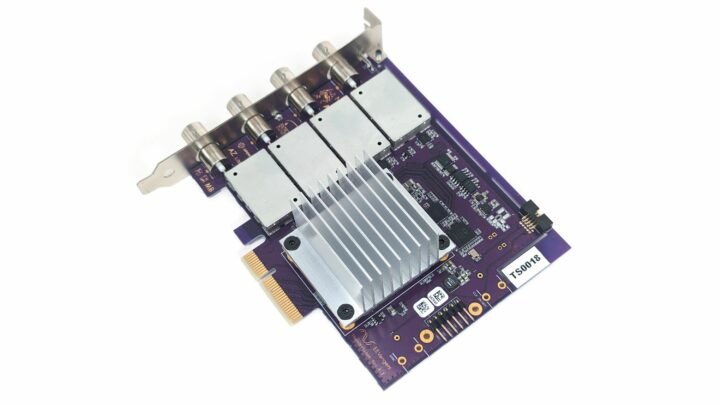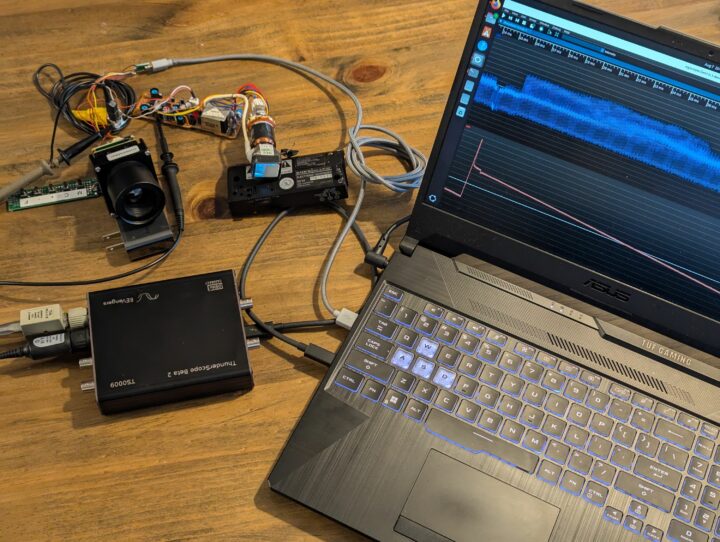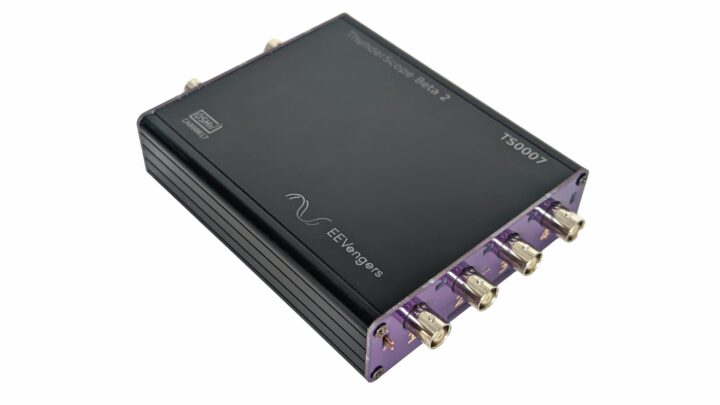The ThunderScope is an open-source, Thunderbolt/USB4 and PCIe oscilloscope with a sampling rate of up to 1 GS/s. It is portable, presents an affordable, open-source alternative to expensive bench-top and PC-based scopes, and delivers a higher sampling rate than most USB oscilloscopes.
ThunderScope streams sample data to your computer for processing and analysis, unlike traditional oscilloscopes which “are limited by their built-in processing capabilities and cramped user interfaces.” It uses the fastest available interface, Thunderbolt, to stream data, allowing it to use your computer’s full potential. ThunderScope is “the only scope that will get better every time you upgrade your computer.”
The Thunderbolt oscilloscope is based on AMD’s Artix 7 XC7A35T-2CSG325C FPGA. It supports up to four channels and a full analog bandwidth of 500 MHz (with the anti-aliasing filter disabled). It doesn’t require an external power source, as it is powered via the Thunderbolt port. It comes in a sturdy, aluminum enclosure with a Thunderbolt port or as a PCIe card that connects directly to a 4x PCIe Gen 2 slot.

There are plans to add a feature to pair multiple ThunderScopes together using the clock and sync connections.
ThuderScope specifications:
- AMD Artix 7 XC7A35T-2CSG325C-based design
- Host Interface – PCIe Gen 2 x 4 (direct or via TBT/USB4), 40 Gbps max
- Streaming Bandwidth to Host – 1 GB/s
- Channels – 4x via BNC connectors
- Analog Bandwidth – 500 MHz
- Input Impedance – 50 Ω,1 MΩ
- Maximum Sampling Rate – 1 GS/s (8 Bit), 500 MS/s (12 Bit)
- Memory Depth – 1 Gpts / channel (current software limit)
- Trigger Types – Edge (more planned), user-expandable trigger types
- Debugging – JTAG
- Power Supply – Host-powered, no additional cables powered
- Dimensions – 145 x 103 x 31 mm (TS), 132 x 120 x 20 mm (TS PCIe)
- Weight – 360 g (TS), 150 g (TS PCIe)
- Supported Operating Systems – Windows, Linux, Mac (in development)

It runs AMD’s XDMA gateware by default, but there is Litex-based gateware (and a Litex hardware control library) as an alternative. ThunderScope’s TS.NET provides precise, hardware control for the gateware, interfaces with the software, and supports full throughput triggering. The primary user interface is powered by ngscopeclient, an open-source and GPU-accelerated frontend for test equipment. ThunderScope is fully open-source and already, there is a live, work-in-progress GitHub repository with documentation, KiCad/Altium hardware design files, firmware, and software.
We have previously taken a look at other open-source USB oscilloscopes, including Bojan Jurca’s “Esp32_oscilloscope”, the 2-channel, Raspberry Pi Pico-based FHDM TECH DSO-500K, and the Analog Discovery 3 USB oscilloscope with an unnamed Xilinx FPGA.
The ThunderScope project began as early as 2018 but was first documented on Hackaday.io in 2021. The crowdfunding campaign went live on Crowd Supply a few days ago and has already blown past its funding goal. The ThunderScope device is priced at $950 for the base package, featuring a calibrated ThunderScope in an aluminum enclosure. It comes with a custom Pelican case and a 40 Gbps USB-C cable. The PCIe version is sold at $800 and includes a custom PCIe bracket. A probe set (one 350 MHz probe, one 250 MHz probe, and two 150 MHz probes) is sold separately for $150. All orders ship for free and are expected to be distributed by July 1, 2025.

Tomisin is a writer specializing in hardware product reviews, comparisons, and explainers. He is very passionate about small form factor and single-board computers.
Support CNX Software! Donate via cryptocurrencies, become a Patron on Patreon, or purchase goods on Amazon or Aliexpress





